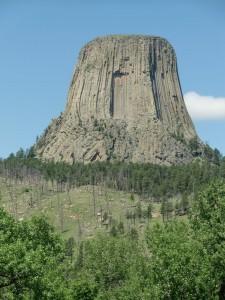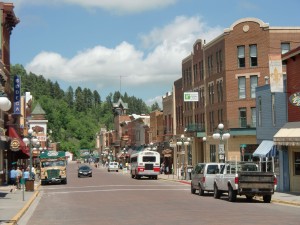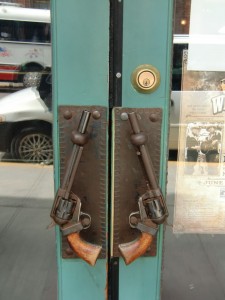THE BEST OF THE WEST – FACES OF STONE
THE BEST OF THE WEST
This is the ninth in a series of articles about traveling the West by bus
FACES OF STONE
By Charles N. Stevens
Photos by Dolores Seidman
We can see this morning that our hotel is perched on top of a velvety green hill in the midst of others just like it. It looks like the type of country where we might expect to see pronghorn antelopes. To the west, in a patch of sunlight, is the town of Sheridan, Wyoming. A brisk wind ripples the American flag, flutters aspen leaves and sings in our window.
Leaving at half past eight, we pass a score board devoted to high school rodeo competition that lists the scores of various schools. It is obvious that the rodeo is king in this part of the country.
We retrace our route back to Buffalo then head eastward. Rolling through miles of undulating green hills we spot many grazing antelope as well as flocks of wild turkeys. The country varies as we travel eastward from green hills to sage brush to occasional forests.
Pausing at Gillette, Wyoming for a break, we come upon a family selling homemade pies and raffling off half a hog to raise money for their son to participate in an NRA shooting contest in Texas.
As we continue toward the east the landscape changes radically, giving us views of strip mined coal leaving a squared-off artificial canyon as well as gas and oil fields. As our road follows the tracks of the Burlington Northern Santa Fe, we see one long train after another, hauling tons of coal. Near Moorcroft we pass grain elevators with long lines of railroad hopper cars waiting to be loaded.
Turning off on Highway 14, we head for the famous Devils Tower. The landscape varies from range land where cattle grazed among oil wells to green hills covered with sheep. Puffy cumulus clouds fatten so that we pass in and out of their shadows. As we climb, we are alternately among ponderosa pine forests and open ranch land. Soon, we have our first glimpse of the Devils Tower in the distance. As we approach, it seems to grow larger and larger, like a great column of rock being extruded upward from the earth. The gray and tan tower rises 1,267 feet out of relatively flat land, making it appear unusually tall and isolated. We note its sharp shadows and the massive columns of basalt that reach for the sky.
We stop at the Devils Tower Trading Post offering a collection of the usual tourist paraphernalia and trinkets, the strains of western music in the background. None of this interests us, so we sit outside in the shade watching motorcycles roar in and the silent drift of cottonwood fluff. The bikers, dressed in tight jeans and leather jackets, are on their way to a motorcycle rally at Sturgess—an event I know nothing about. They wear no helmets, their long hair flying or bound by bandanas as they speed by.
Moving on, we arrive in Deadwood, South Dakota in the early afternoon. The old gold rush town is basically one long street of 19th century buildings filling a narrow valley fringed with pine trees. The Black Hills gold rush began in 1876, giving birth to the town. Wild Bill Hickok lived here, but was shot and killed in a local saloon while holding a poker hand of aces and eights. Calamity Jane also resided here and is buried alongside Hickok in the local cemetery.
Today, Deadwood is a town of restaurants, hotels, bars and gift shops all carrying out the theme of the old west. We walk up and down the hot main street noting that many establishments are full of the sounds and glitter of slot machines, carrying out the gambling motif of the town. The whole town reminds us of a movie set. The street resounds to the thunder of motorcycles and an occasional log truck. At the now defunct railroad station we watch a movie about the town and listen to a living history talk by “Calamity Jane.” The entire town is a Registered National Historic Landmark.
Not far away, we pause at Lead (pronounced “Leed”), South Dakota where we see a huge open pit gold mine, the Homestake Mine. It is the largest, deepest and was, until it closed in 2002, the most productive gold mine in the Western Hemisphere. This town too is a product of the 1876 gold rush and is also a historic landmark.
Not long afterwards we arrive at Keystone, South Dakota and the White House Hotel, both very close to Mt. Rushmore. After a short rest we drive to the site of Mt. Rushmore and the great stone faces—Washington, Lincoln, Jefferson and Teddy Roosevelt— carved in the pale rock, the first sight of them taking our breath away. We walk under rectangular stone arches then are directed to a large cafeteria where we will have dinner. We had felt a few drops of rain on the way in, but now a violent thunderstorm unleashes wind, torrents of rain and near constant lightning and thunder. After several close bolts the lights in the cafeteria go dark, but thankfully come on again.
By the time we finish eating, the storm has rolled off to the east, the eastern quadrant flickering in a dazzling display of electric-blue lightning. As the skies gradually clear and the wet walkways dry, we gather at the outdoor amphitheater where a ranger delivers a talk about Lewis and Clark. This is followed by a film about the presidents displayed in the rock and what they contributed to America. We look up at the stone faces, floodlights illuminating those famous men, still in awe that such a sight is possible, that Gutson Borglum who designed it and four hundred workers could bring about such a marvel.

Devils Tower, over one thousand feet in height, seems to rise out of the land.

The old mining town of Deadwood is a single avenue of l9th century buildings.

Keeping with the western theme of Deadwood are these unique door handles.

We finally reach Mt. Rushmore and our four great presidents in the last light of day.
MONTEREY PARK AUTHOR PUBLISHES 3RD BOOK ABOUT HIS EXPERIENCES IN WORLD WAR II- BACK FROM COMBAT
Charles “Norm” Stevens, a 40 year resident of Monterey Park and World War II Veteran has recently published the 3rd in his series about his cheap clomid experiences in WW II, Back from Combat: A WWII Bombardier Faces His Military Future. This book details the time from when he returned from combat in England where he flew 34 missions over Germany and France until the end of the war. Faced with large numbers of returning combat vets, and not knowing how long the war would continue, the military had to plan for their future. His options were whether to return to combat, become an instructor in the U.S., or receive new training that he would use in the Pacific. The book concludes with the end of the war with an Afterward that includes an update on the B-l7’s still flying in the U.S., as well as present day accounts pertaining to the war.
Stevens is the author of two previous books about his experiences:
An Innocent at Polebrook: A Memoir of an 8th Air Force Bombardier (Story of his 34 bombing missions from his base at Polebrook, England over Germany and France)
The Innocent Cadet: Becoming A World War II Bombardier (A prequel to the first, telling of his training in the U.S. before going overseas into combat.)
He is known to the readers of The Citizen’s Voice as the author of Travel Log Articles including “From Paris to Normandy on the Seine”, “Exploring New York” and “In Search of Snow.” He is retired, having taught for 32 years, primarily in the Montebello Unified School District.
Those interested in purchasing an autographed copy of any of his books, may contact the author at 323-721-8230 or Normstevens24@gmail.com.



